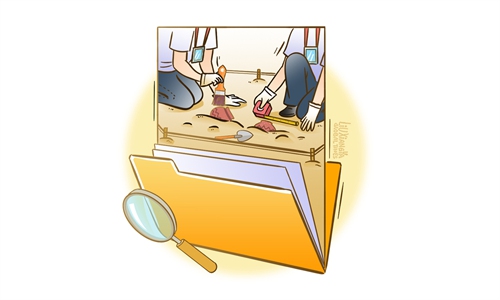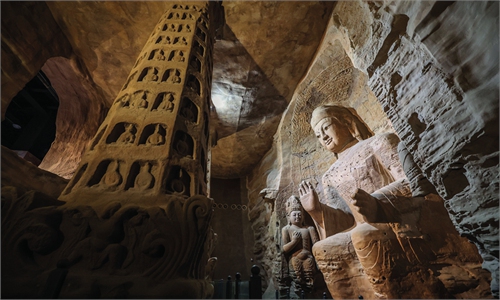ARTS / CULTURE & LEISURE
Interdisciplinary technologies bring more cultural relics to life
Wings to soar

An archaeologist digs out a dragon head relic at the Guzhou ruins in the Xiong'an New Area, North China's Hebei Province. Photo: Courtesy of the Institute of Archaeology at the Chinese Academy of Social Sciences
In a fully equipped laboratory in Beijing, a dragon-head architectural component from the Tang Dynasty (618-907) discovered at the Guzhou ruins in Xiong'an New Area, North China's Hebei Province is prepped for a CT scan.
Thanks to the use of CT scans, 3D modeling, and other high-tech facilities in this laboratory, the restoration and research of the dragon head is progressing smoothly. The Key Laboratory of Archaeological Sciences and Cultural Heritage at the Chinese Academy of Social Sciences (CASS) is promoting the revitalization of more cultural relics with the help of technology, and has become a new example of cutting-edge technology used in archaeological work.
In recent years, China has intensified efforts to integrate technology into archaeology. Remote sensing satellites have been used to accurately document the shapes of excavation sites, 3D imaging can reconstruct collapsed underground spaces, and 3D digital modeling is now used to reverse-engineer and replicate decayed wooden boxes. Advances in deep-sea technology have expanded China's underwater archaeology from depths of 50 meters to 2,000 meters.
These interdisciplinary collaborations are uncovering the limitless potential of archaeological science and continually enhancing China's ability to protect cultural heritage.
"Technology and archaeology have always been areas of interdisciplinary integration and collaboration. Over the last century, the development of archaeology, from its traditional roots to the present, has been closely intertwined with technological advancements," Chen Jiachang from the China Academy of Cultural Heritage told the Global Times.
"From the early integration of geology and archaeology to the modern-day application of advanced technologies, these innovations have increasingly aided archaeologists in analyzing remnants of ancient societies, reconstructing their structures, and understanding their social forms," Chen said.
Technological power
The new laboratory consists of 13 sub-laboratories for archaeological sciences, five for cultural heritage conservation, and five joint archaeological laboratories. It integrates advanced technologies from disciplines including molecular biology, chemistry, geosciences and physics to facilitate interdisciplinary and inter-institutional research in archaeological science and heritage conservation.
Following laboratory analysis and preliminary cleaning of the dragon head's eyes and nose, large areas of paint were found on the gray ceramic surface. The dragon's pupils are black, while the eyeliner around them is green.
Liu Yong, head of the Key Laboratory of Archaeological Sciences and Cultural Heritage, recalled to the Global Times that "the top part of the dragon head is missing, and cracks can be seen in its nose and eyebrows, preventing any movement of the artifact."
So further discovery of the dragon's pupil and eyeliner colors can't bear any more movement on the artifact.
One key reason has influenced the team's decision to use curved-surface fluorescence technology to create a 3D model of the painted artifact. Fluorescence, with its penetrating properties, interacts with different elements to reveal colors hidden beneath layers of soil. "Normally, the green color shines from malachite, while the white ears are calcium carbonate, but we can only figure it out after the fluorescence test."
"Because it couldn't be moved, we used soil packing to stabilize it and employed CT scanning to examine whether the dragon head was solid or hollow," Liu explained. "CT technology is primarily used on artifacts for pre-detection. It helps assess the preservation status and internal structure and provides information for protective cleaning."
The development of portable CT technology has also transitioned such equipment from fixed to mobile, allowing for better balancing of artifact protection and research. "The goal is to maximize archaeological information while protecting the artifact," Liu said.
Increasingly, not just field archaeologists but also physicists, geologists, and experts from various other fields are becoming involved in this emerging field of archaeological science.

A diver searches for underwater relics with a detector. Photo: VCG
Wider applications
From aerial and drone remote sensing to satellite remote sensing, these increasingly advanced technologies provide a broader distribution of data about archaeological sites, enabling more comprehensive hypotheses about historical scenarios.
"In the past, we used radar. Satellite remote sensing offers higher density points, forming more detailed surface information," Chen said. "Now the application of technology helps archaeologists clarify ancient societal remains."
Chen explained that technologies such as residue DNA analysis and isotope analysis, combined with archaeological interpretations of historical records and research, create a chain of factual evidence for the reconstruction of ancient societies. "It's a collaboration across disciplines - unifying science and archaeology."
However, even with advancements in technology and conservation, challenges remain. Natural weathering continues to pose problems for artifacts like the Yungang Grottoes and the Leshan Giant Buddha.
The conservation of stone grotto artifacts faces three main challenges: structural reinforcement, water infiltration prevention, and weathering resistance. While grouting and other techniques can address the first two problems through innovative approaches tailored to the artifact, combating weathering - considered a global challenge - requires breakthroughs in material research.
"Just as chip manufacturing needs new material development, creating advanced infiltration reinforcement materials is key to preserving grottoes," Chen said.
There are more advanced technologies playing necessary roles in China's significant archeological projects beyond the conservation of stone grottoes. For instance, in the conservation of Sanxingdui artifacts, the application of ivory analysis revealed similarities in structure and materials to those of stone grottoes. This fusion of technology and archaeology has allowed Sanxingdui artifacts to gain renewed life.
Ultimately, the goal of technology in archaeology is to reconstruct the framework of ancient societies, revealing the structures and dynamics of human life within their historical contexts. "Archaeology and technology complement each other, creating a synergistic effect," Chen concluded.




